September 3, 2010
Air Date: September 3, 2010
FULL SHOW
SEGMENTS
Dude, Where's the Oil?
View the page for this story
There has been a lot of debate about how much BP oil still remains in the Gulf of Mexico. Government officials have said most of it is gone. Other researchers report that 75 percent is still there. Woods Hole marine chemist Christopher Reddy explains to host Jeff Young that science takes time and the results aren't necessarily contradictory. (06:00)
Chalmette Update
/ Jeff YoungView the page for this story
Oil spills are nothing new for the working class town of Chalmette, Louisiana. Hurricane Katrina let loose a million gallons of oil in a residential neighborhood there. Host Jeff Young revisits the people of Chalmette five years later to see how they’re coping. (06:00)
The Pollution/Diabetes Link
View the page for this story
A recent long-term study out of Germany found that the closer participants lived to major roads, the greater their risk of developing type 2 Diabetes. Host Jeff Young talks with Dr. Wolfgang Rathmann, the study leader and researcher at Dusseldorf University's Diabetes Center, about what he found. (06:10)
It's No Copenhagen
/ Ingrid LobetView the page for this story
A bicyclist movement is surging as commuters join weekenders in common cause. Even traffic-choked Los Angeles is under pressure to become more bike friendly, as Living on Earth’s Ingrid Lobet reports. (07:10)
Tern, Tern, Tern
/ Mark Seth LenderView the page for this story
A tern, on the hunt for food, is a determined seabird. And a mother tern is even more determined when her mission is to feed and protect her young. Mark Seth Lender offers his observations. (03:10)
Deepest Places
View the page for this story
The 2004 expeditions to find the deepest place on Earth, like many other significant terrestrial discoveries, were rife with competition, danger and intrigue. Author James Tabor wrote about these events in his book “Blind Descent: The Quest to Find the Deepest Place on Earth,” and talks with Living on Earth’s Steve Curwood. (07:30)
Science Note: Belching Sheep
/ Amanda MartinezView the page for this story
Sheep burps produce methane – a gas that contributes to climate change. Now researchers are suggesting a novel solution to minimize the greenhouse gas: seasoning the sheeps’ food. Living on Earth’s Amanda Martinez reports. (02:05)
A Man and His Chainsaw
/ Laurie SandersView the page for this story
Ken Packie knows how to wield a chainsaw. At his Berkshires, Massachusetts studio, he uses it to create works of art from big chunks of wood. Producer Laurie Sanders reports on this chainsaw sculptor extraordinaire. (05:15)
This week's EarthEar selection
listen /
download
Show Credits and Funders
Show Transcript
HOST: Jeff Young
GUESTS: Christopher Reddy, Wolfgang Rathmann, James Tabor
REPORTERS: Ingrid Lobet, Laurie Sanders
COMMENTATOR: Mark Seth Lender
SCIENCE NOTE: Amanda Martinez
(THEME)
YOUNG: From Public Radio International - this is Living on Earth.
(THEME)
YOUNG: I’m Jeff Young. Sifting though the scientific studies. Just how much of BP’s oil is still lurking in the Gulf of Mexico?
REDDY: Prudence is a virtue in this case so just waiting and doing good science will answer your question. But we just don't live in a world of CSI and those other TV shows where you get an answer in eight seconds. It just takes time.
YOUNG: But journalists and the public are impatient for answers now. Plus, the virtues and headaches of bicycling in the west coast’s most car-centric city, Los Angeles.
SNYDER: Look, if this lane is too narrow to share, it’s not because my vehicle is too wide, it’s because your vehicle is too wide, I’m not taking up so much space, I’m not polluting the air, so why shouldn’t I have at least as many rights?
YOUNG: Nobody walks in LA but more are pedaling…Those stories, and more, this week on Living on Earth! Stick around.
(NEWSCAST)
Dude, Where's the Oil?
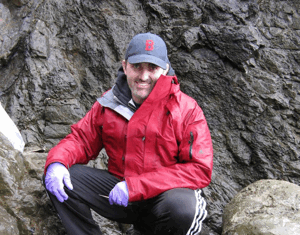
Christopher Reddy is a marine chemist for Woods Hole Research Institute (Woods Hole Research Institute)
YOUNG: From the Jennifer and Ted Stanley Studios in Somerville, Massachusetts, this is Living on Earth. I’m Jeff Young. We’ve been whip-sawed lately by conflicting accounts of just how much of BP’s oil is still in the Gulf. A government report gave the impression that most of it was gone. Then, scientists with the Georgia Sea Grant program concluded that most of it is still there… suspended underwater. The journal Science published a study by the Woods Hole Oceanographic Institution documenting an oil plume, then published another study suggesting that microbes were eating that submerged oil. We’ve asked Christopher Reddy to help us understand what’s going on. He’s a marine chemist at Woods Hole.
REDDY: I was a part of a real superstar group of team of scientists and then, during the last two weeks of June, we used a series of different types of technology to identify and track a plume that existed about a half mile deep below the ocean that went out about 22 miles long.
YOUNG: How do you account for the differences in these reports that we are hearing from different teams of scientists? Because to the lay person, it’s pretty darn confusing….
REDDY: Yeah, well. (laughs). You know, these initial estimates are really more like a rough estimate. They help you, kind of, set a road map as to where you are going to head. And they allow you with more time, and more science that goes on, allow you to have a much more improved finished product. The fact that two groups disagree as to the starting point is…that’s just science.

Christopher Reddy is a marine chemist for Woods Hole Research Institute (Woods Hole Research Institute)
YOUNG: You wrote an essay about your experience trying to communicate the science and how it was presented in news stories and you wrote: “It is incumbent on scientists and journalists to keep the results in perspective and refrain from veering into misleading waters. Unfortunately, in this case, both parties failed.” So, what went wrong?
REDDY: I think the scientists probably didn’t set the results up in the context of these two potentially conflicting reports- I didn’t think they were conflicting. On the flip side, I think journalists, and there’s not many science journalists as much as there used to be, so I think some journalists kind of think about these science cases much like the OJ Simpson case, where there’s something new everyday, per se. And I think that they were expecting that our story would be following on the heels of the last two, you know, news releases, almost like a Charles Dicken’s serial novel. And that’s just not the case of how science works. You know, we just don’t live in a world of CSI and those other TV shows where you get an answer in eight seconds. It just takes time.
YOUNG: Did you get the sense that while you were looking for some light here, some of us in the media were looking for the heat? Trying to look for the conflict?
REDDY: Yeah, sure, I mean, there was. But that’s what sells newspapers and I understand that. You know, I think it was a whole series of crossed wires. I mean, I think, you know, there was a big press release and press conference about the results from our study showing evidence of a plume, and it was right on the heels of two other stories. So, it kind of seemed obvious to a lot of people that we were the third round, you know, of this ongoing battle. And, in reality, we were just a small piece of the pie of a very, very big bakery called the Gulf of Mexico. You know it’s a big piece of science that has to be done to understand the whole aspect of the spill.
YOUNG: What might scientists have done better to communicate all this?
REDDY: One of the problems that, you know, my colleagues and I have is that we often critique science very hard. I mean, we’re really pretty tough on each other. And sometimes, when we’re asked by the journalists what we think of a paper… I might think it’s a really good paper, but I may say, ‘oh, but I don’t really believe in what they say in Figure 3,’ but that doesn’t necessarily mean that I think these people are bad scientists. I think what’s happening is, you’ll get scientists speaking to a journalist and critiquing a paper like they’re speaking to their office mate, who would kind of take the big picture, where I think the journalists may magnify, you know, the one little misgiving I may have.
YOUNG: So, what’s the lesson there? Not talk to journalists, or change the way you talk to journalists?
REDDY: No, no. I think that scientists would do well by understanding a little bit about what a journalist’s life is, that your regular beat reporter, you know, works on the time scales of three to five, six hours. Regular scientists works on the time scales of six, 10, 12 months. Many of the journalists, you know, in the morning may be covering in the morning a car crash, in the afternoon an oil spill. And so, I don’t think the scientists understand the life of a journalist. And I think if they did, and they listened to the questions they may be able to help out science better in the long run. They also have to understand that they have to say ‘no’. And, they also have to say ‘I have no comment’, and I think sometimes, you know, we get so excited that somebody finally cares about what we have to say they may ask a question that leads us down a path that we really can’t get out of.
YOUNG: What can we learn here from previous spills, say, with the Exxon Valdez, how long was it before some scientists really had their arms around what had become of that oil?
REDDY: Well, the Valdez spill, there was a very nice paper written by some outstanding scientists about five years after the spill who tried to answer all those questions.
YOUNG: Five years?
REDDY: Five years. There’s so much attention on this spill that, you know, things could move faster, that doesn’t mean any sloppier, but I would hope that maybe in about a year from now, there might be five or ten people still sitting in a room and spend about a week and crunch some numbers and they might be able to give you the number that’s probably pretty robust. That would seem reasonable to me. You know, we work at a pace of prudence, and I think a lot of the audience works on a pace of urgency. And, in most cases, those don’t mesh.
YOUNG: Christopher Reddy is a marine scientist at the Woods Hole Oceanographic Institution. Thanks very much for your time.
REDDY: Yeah, my pleasure.
Related links:
- Woods Hole Oceanographic Institution
- Click here for a PDF of the NOAA report
- Georgia Sea Grant on the Oil Spill
Chalmette Update

Chalmette resident standing by his new house. (Photo: Jeff Young)
YOUNG: Well, federal and state officials are still trying to assess the damages from some oil that hit Louisiana’s coast—no, we’re not talking about BP’s oil. We’re talking about the hundreds of spills that let loose some 11 million gallons during Hurricanes Katrina and Rita five years ago.
One spill hit Chalmette, a blue-collar community in Louisiana’s St Bernard Parish. The week after Hurricane Rita in September, 2005, I visited with some residents picking through their oily, watery homes.
[SLOSHING BOOTS]
LICCIARDI: And it's not looking too good at all. I see a lot of oil all over everything. I really don't even want to go in. (Sighs)
YOUNG: Charles Licciardi’s house sat along the fence line of a refinery owned by the Murphy Oil Company. A 250,000-barrel storage tank had not been properly secured before the storm. Hurricane Katrina’s surge caused the tank to float and then burst, topping the receding floodwater with over a million gallons of oil.
LICCIARDI: If we just had the water we could probably rebuild, but with the oil I think that's gonna eliminate that possibility – which I lived here my whole life, so I need another home. Huh!
YOUNG: The oil hit about 1,700 homes over a square mile. Murphy Oil quickly cleaned up the streets and nearby canals, but cleaning residential properties was a problem. Murphy Oil construction manager Kevin Roussell promised his company would be a responsible neighbor.
ROUSSELL: Murphy will do the right thing by these people. It's our community. You know, all of our people live here just like they do. We've been here 50 years and we gonna be here 50 more.
YOUNG: That was five years ago. This summer, I went back to see how the people I’d met in Chalmette were doing.
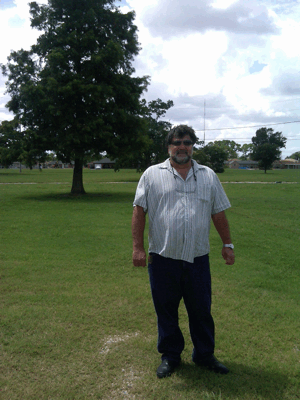
Chalmette resident standing where his house once was. (Photo: Jeff Young)
[LICCIARDI GREETING JEFF …“Hi, how you doin’ Jeff? Mr. Licciardi, how are you? Good to see you. Call me Charlie.”]
YOUNG: Charles Licciardi, who’s now 58, lost his teaching job because most Parish schools were not rebuilt after Katrina. He’s getting by as a Justice of the Peace, officiating at weddings. Like a lot of his neighbors, Mr. Licciardi faced a tough decision about whether to rebuild after the oily flood. Traces of contamination in soil samples left him with too much uncertainty.
LICCIARDI : We wouldn’t know deep into the soil what’s in there. I mean, if you have your children, grandchildren, or yourself outside barbecuing, you know, what are you walking on?…And things like that. I felt that it was in everybody’s best interest to not rebuild there not knowing what contamination would actually be in years to come.
[TRUCK DOOR CLOSES]
YOUNG: We climb into his pickup truck for a tour of the old neighborhood. There’s not much left to see.
LICCIADI: All this now is owned by Murphy Oil refinery and these were all our families and friends that used to be here. I don’t even know if I can pick out my lot anymore. When we get there we’ll have to see.
[CAR INTERIOR SOUND]
YOUNG: The tidy, single-story brick houses are mostly gone, replaced by grassy lots and the occasional concrete slab. Mr. Licciardi spots a tree on the plot that was once his home.
LICCIARDI: yeah, see that cedar tree there, I planted that tree. It was actually a twig, it was about, maybe two feet high when I planted it. And those things grow pretty good, you can see how thick and full it is. Of course, it don’t belong to me anymore.

Chalmette resident standing by his new house. (Photo: Jeff Young)
YOUNG : You could say Charles Licciardi and Murphy Oil grew up together here in Chalmette. Fifty years ago, the refinery was about the size of an average gas station. Now, it’s a sprawling complex of tanks and smokestacks. Mr. Licciardi lived 30 years on this street, facing the west fence of the Murphy refinery. Before that he worked the family farm on the east side of the refinery, on land his grandfather bought when he came to the U.S. from Italy.
LICCIARDI: He just happened to get the ones on each side of Murphy. We farmed it. When I was a small child, I remember picking tomatoes and corn, and driving mules and what not. All of this was real fertile, fertile land and we grew a lot of vegetables here, sold them at the French market.
YOUNG: The farm is long gone. Murphy oil continues to grow with land acquired in a class action settlement with residents after the spill. The refinery’s building a new lab facility on the plot where Mr. Licciardi’s mother and sister once lived. Mr. Licciardi’s not happy with the settlement. He thinks he got only about 40 cents on the dollar for his property. Murphy Oil declined to comment.
[TRAIN HORN BLOWS, THEN PASSES]
YOUNG: Mr. Licciardi and his wife now live in a small white trailer near the railroad tracks a little more than a mile from where his old house stood, on a short gravel road called Licciardi Drive. Murphy Oil is still their neighbor. The trailer’s so close to the refinery they can feel the heat from the flares that burn impurities from the oil.
Now the BP oil crisis brings on a strange sense of déjà vu. Mr. Licciardi’s entire state faces the same lingering uncertainties about oil contamination that his community lived through. And the omnipresent ads from BP, promising to make things right, also seem eerily familiar.
[BP AD: “BP IS GONNA BE HERE UNTIL THE OIL IS GONE, AND THE PEOPLE AND BUISNESSES ARE BACK TO NORMAL. UNTILWE MAKE THIS RIGHT.”]
LICCIARDI : They’ll make it right? (laughs) I’m not laughing because it’s funny, but I’m laughing because it’s just outrageous. They can’t make it right, they’re not going to make it right. They’ll make it right for them! But for the people… I doubt it very seriously. I lived through it and it hasn’t been made right for us and I don’t see them making it right for anybody else, other than themselves.
YOUNG: You can see pictures of Chalmette, then and now, at our website loe.org.
Related links:
- Listen past Chalmette stories from the LOE archives
- Listen past Chalmette stories from the LOE archives
- Click here to learn about the Murphy oil spill from the EPA
- More from the EPA on the Murphy oil spill
[MUSIC: Led Zeppelin “No Quarter” from Houses Of The Holy (Atlantic Records 1973)]
The Pollution/Diabetes Link
YOUNG: It’s Living on Earth, I’m Jeff Young. And, we already know that air pollution harms hearts and lungs. But a study in the journal Environmental Health Perspectives adds a new hazard: air pollution could also lead to type 2 Diabetes. A long-term study from Germany has some intriguing results. Dr. Wolfgang Rathmann is the study leader. He's a researcher at Dusseldorf University's Diabetes Center. Dr. Rathmann, welcome to Living on Earth.
RATHMANN: Hello!
YOUNG: Now, your study followed about 1,800 healthy middle-aged German women over the course of almost two decades, in some cases. Tell me what you found.
RATHMANN: Yes, we have investigated the relationship between air pollution and new cases of type two diabetes in a cohort of 55 year old women, which lived in the industrialized route of West Germany, and also a control group in non-industrialized towns nearby. And between 1990 and 2006, 178 women were newly diagnosed with type two diabetes in this cohort. And, we found that exposure to components of traffic pollution, particularly nitrogen, dioxygen, fine particulate matter were significantly associated with a higher risk of type 2 diabetes in these women.
YOUNG: Well, how might air pollution be contributing to diabetes?
RATHMANN: We think that inflammation plays an important role. We know form several studies that low-grade inflammation is associated with impaired glucose metabolism and also with type two diabetes. Because these inflammatory markers impair insulin action and have affects on several cells that are related to the development of type two diabetes. There was a publication on an experiment that mice were exposed to air pollution and there was also a control group of mice with normal air. And, what was interesting was that those mice who were exposed to air pollution had an inflammatory response. They had higher immune makers in the blood, and also what was shown in this study was also, that they had some disturbed glucose tolerance.
YOUNG: How significant a factor do you think this is? I mean, what we hear mostly about is diet. Is this on par with diet in terms of your chances of developing diabetes?
RATHMANN: Obesity, low physical activity, a certain diet which all triggers stimulation of the immune system and we think that traffic-related air pollution is another player in this concept. We know from several pervious epidemiological studies that people who live in an urban region have a higher likelihood to develop type two diabetes than people in rural areas. And this is especially true in developing countries undergoing rapid industrialization. We found that diet or physical activity do not completely explain the increased diabetes risk.
YOUNG: So there’s something about air pollution that’s causing our bodies to respond with this inflammation, and there’s something about that inflammatory response that’s leading us to be more vulnerable to diabetes?
RATHMANN: In a sense, yeah. And, what comes first is the question. First inflammation and then you have some air pollution and then you get diabetes…I think it’s what we call in medicine a multiple hit. So, if you have several risk factors hitting in the same direction like obesity, smoking, low physical activity, genetics and then air pollution, and they all point in the same direction that your immune system is activated but higher than in healthy people, then this will make disturbances in the body that the insulin action is disturbed or impaired which eventually leads to type two diabetes. So, we don’t think that air pollution is the one and only factor, but it’s a new one, and another one. And, as we said, a preventable one.
YOUNG: And in your study, the closer someone lived to the highway, the higher their chance for diabetes?
RATHMANN: That’s correct. We found that living within 100 meters of a busy road, which means there are more than 10,000 cars per day, more than doubles the risk of diabetes. And this was in particularly true in women with a lower educational level.
YOUNG: You say this is potentially a modifiable risk factor. How might we modify this risk factor for diabetes, if in fact the other studies confirm what you found?
RATHMANN: The importance may be even more outside Germany or the US, because we know that in some Asian and Latin American countries, air pollution is over ten times higher. For instance, in China, we saw a huge increase, more than ten-fold higher diabetes prevalence, during the last 20 years or so, and this can not only be attributed to physical activity or changes in diet alone. Therefore, preventive actions should be carried out to reduce air pollution, in order also to prevent diabetes. These actions can also be expected to have additional benefits because air pollution increases the risk of cardiovascular and lung diseases. And, I expect that with in the next few years we see another set of new risk factors emerging, which are more related to the environment and not to the behavior of the patient. And this will lead to new perspectives in prevention.
YOUNG: Dr. Wolfgang Rathmann at Dusseldorf University's Diabetes Center. Thank you very much!
RATHMANN: You’re welcome!
[MUSIC: Undersea Poem “Make Me Happy” from Undersea Poem (Six Degrees Records 2010)]
It's No Copenhagen
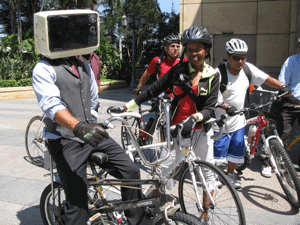
Stella Ngigi and other bikers at the L.A. bike summit. (Photo: Ingrid Lobet)
YOUNG: It takes guts to ride a bicycle in the nation's most crowded county, Los Angeles. It's not just the traffic, it’s the rundown roads and the stressed-out drivers. Yet, more people than ever are commuting by bike. And now, thanks to one fateful broken elbow, cycling in LA may be getting some real traction. Living on Earth's Ingrid Lobet has our report.
[BUSY STREET]
LOBET: At the foot of the soaring Metro Transit Authority building, cyclists dismount and hand their bikes to a valet. Louis Moya, dressed in a Fender guitar T-shirt and glasses, describes what it’s like to ride in LA.
MOYA: Um, well, no bike lanes, cars opening doors, just swinging them open without looking back, cracked roads, potholes… And, people driving really close to you, they start honking at you. They yell at you, you know, ‘get off the road, get on the sidewalk.’
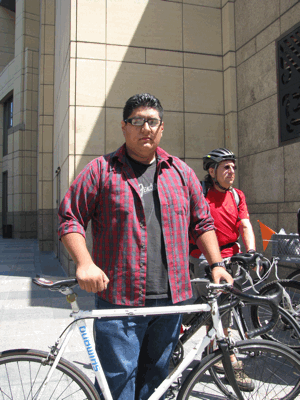
Louis Moya at L.A. bike summit. (Photo: Ingrid Lobet)
LOBET: These conditions are what motivated a couple of hundred cyclists to attend a Bike Summit called by Los Angeles Mayor Antonio Villaraigosa. He opened on a solemn note.
VILLARAIGOSA: Lemme just say, unfortunately, today a cyclist was killed in a traffic accident in the San Fernando Valley.
LOBET: That cyclist was only one of several to lose their lives on Los Angeles streets in recent days. One woman, 31, was pregnant. And the mayor recently had his own near miss.
VILLARAIGOSA: I was going 16-18 miles an hour, hit headfirst. Then hit my elbow. My elbow was the size of a grapefruit. It’s shattered in eight places and I have a plate from my elbow almost about two-thirds of the way to my wrist. So, imagine what would have happened if I wasn’t wearing a helmet.
LOBET: The severity of the mayor’s injury did not stop former Los Angeles Mayor Dick Riordan, a cyclist still, at age 80, from goading him.
RIORDAN: So here’s what we bought for you…
[SOUNDS OF BAG RUSTLING]
RIORDAN: It’s a set of training wheels.
[LAUGHTER]
LOBET: But serious frustration has been growing among people who rely on bicycles across this vast city. The chance to describe the conditions they endure directly to city officials was without question a turning point. Brent Butterworth and several others stressed the hostility they often encounter from drivers.
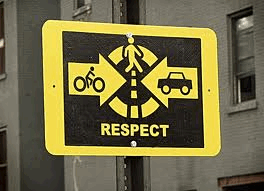
Pro-bicycling signage
BUTTERWORTH: I was yelled at twice last night for making legal left hand turns on my bike. And, you know, I survived, but I left two drivers who now hate cyclists even worse. The problem is these people are running around with a set of laws in their head that they basically made up. they have no awareness of what bicycle laws are.
LOBET: The riders got no disagreement from Rita Robinson, LA’s general manager for transportation.
ROBINSON: We have a car-centric mentality in this city. It is our hope to be able to implement a plan that we can be proud of on a regional basis, not to mention, educating the drivers that you deserve to be there.
LOBET: Vehicle laws here give cyclists the same rights and responsibilities as cars. To publicize that fact, some cities are posting signs instructing drivers to share the road. When the message is painted on the street, it’s called a sharrow. Of course a major priority for cyclists is more separate bike lanes and bike paths. And, to that end, the mayor promised a fivefold increase in new lanes each year.
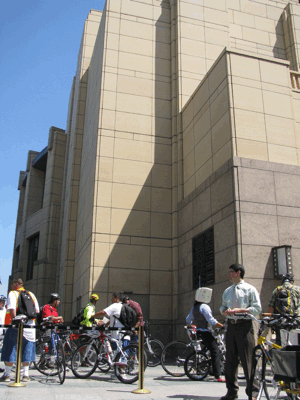
Bike valet at L.A. bike summit. (Photo: Ingrid Lobet)
VILLARAIGOSA: And at that rate we’ll build about 200 miles every five years.
LOBET: But in a moment that captured both the frustration and the flavor of this giant city, Ramon Martinez of the LA County Bicycle Coalition pressed the mayor to move faster.
MARTINEZ: Antonio, if you are really interested in moving quickly on bike lanes-- there are bike lane projects in the downtown street centers that can be done downtown Los Angeles in dense areas that are transit-dependent, today, right now, with your support.
VILLARAIGOSA: I gotcha, Ramon.
[APPLAUSE]
LOBET: In a way the hearing was a culmination of efforts already underway. The city was already finishing up a bike plan. Los Angeles police have been paying more attention when cyclists complain of abuse. A new street sign warns drivers to leave at least 3 feet of space when they pass a bike. They’re all responses to the growing number of people demanding safe bike travel.
SNYDER: I’m convinced we’ve at least tripled the number of people on bicycles in Los Angeles in the last few years.
LOBET: Ryan Snyder has been working on pedestrian- and bicycle-friendly urban planning here since the ‘70s, now, as a consultant.

Stella Ngigi and other bikers at the L.A. bike summit. (Photo: Ingrid Lobet)
SNYDER: This is a global movement. And it’s exciting to be a part of it, especially having been involved when many people just thought the idea of bicycles ever becoming a meaningful part of the mix of transportation modes in the city as a crazy idea.
LOBET: But Los Angeles is a follower, not a leader in this movement, and has a lot of catching up to do.
SNYDER: When you look at the cities that are doing the most, lets see, Minneapolis, Seattle, Portland, Tucson, Chattanooga, Tennessee, Columbus, Ohio, and a growing list of other cities. The only thing those cities have in common is the political will to make conditions better. We have a great climate here, most of our basin is flat, there is no reason that we can’t do, certainly, as well as New York and Chicago.
LOBET: Los Angeles may enact one first for bicycles. City attorney Judith Reel says a new ordinance could make it easier for riders to take on harassing drivers in court. But she stresses, many things riders complain about are already illegal.
REEL: Threatening a bicyclist can be a criminal violation, making an unlawful threat.
LOBET: What about cars that deliberately might pull out in front of a bicyclist?
REEL: That action would violate the vehicle code, they would be following too closely. And if they tried if they tried to hit a bicyclist, that could be deemed an assault with a deadly weapon.
LOBET: What about motorists who sometimes hit the horn just to see if they can startle you?
REEL: Honking a horn at a bicyclist for reasons unrelated to vehicular safety is a violation of the vehicle code.

Pro-bicycling signage
LOBET: But most of the time, these acts can’t be proved beyond a reasonable doubt, so prosecutors aren’t going to file charges. The new ordinance would provide a civil remedy, meaning a lower standard of proof, and something cyclists could pursue on their own.
REEL: The city could pass a law that would give someone who is unlawfully harassed the right to sue for that and could also award punitive damages, treble damages and attorneys’ fees.
LOBET: Most cyclists, though, prefer coexistence to lawsuits. And some see this as a larger movement, of public health workers, disabled and older people, advocates for school kids, coming together for more walkable, bikable cities.
On October 10, Los Angeles, will close 8 miles of downtown streets to cars. Other cities have done it, but it will be a first in this town, where for so long, status has meant your four-wheel ride. For Living On Earth, I’m Ingrid Lobet in Los Angeles.
Related links:
- Click here for a slide show of LA bike photos
- LA Streets Blog
- LA Bicycle Advocacy Group
- LA City Bike Plan
- LA Riders Group
- Biking Blog
- First LA DIY Bike Shop
- LA as Livable City blog
- Group that promotes cycling in LA
- Closing Streets to Cars
- National Livable Cities org
- Los Angeles County Bicycle Coalition
[MUSIC: Monty Alexander “Sneaky Steppers” from Yard Movement (Island Records 1996)]
Tern, Tern, Tern
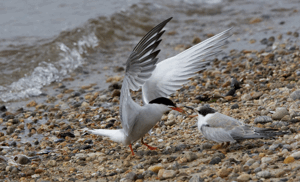
(Salt Marsh Diary ©)
YOUNG: The terns that live on America’s Atlantic coast are in trouble. The meager habitat that remains to them, beaches and a few near-shore islands are highly vulnerable to human disturbance, especially during breeding season. Scientists say the best thing people can do for terns is leave them alone. And if you do – as writer Mark Seth Lender found – sometimes terns will return the favor.
LENDER: Tern hovers, then tumbles from the sky. “X” marks the spot where she enters, a cross made of the splash of her spray and the splice of her wings. Beneath lies Sunken Treasure. She alone knows what to Seek and where to Find.
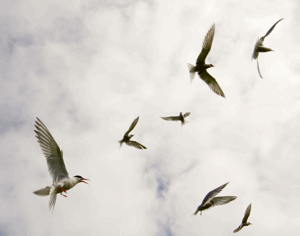
Terns flying. (Salt Marsh Diary ©)
Tern rises from the dark surface, her body shaped now like a “V” and mirrored in the V-shaped wake of water that strays behind her. “V” for Victory, though of all the boot’ and bounty of the sea, only a single silver minnow flashes in her bright orange beak.
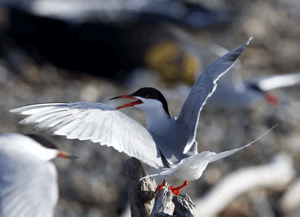
(Salt Marsh Diary ©)
Tern does not spend her meager winnings but holds, as if to savor. Tern tacks toward land. Others of her kind hail and sometimes join her. Just offshore they come to rest on a buoy or piling, a transient place of mooring. Elaborate conversations ensue, words of greeting, sometimes angry warnings to gull or cormorant who’ve come too close. It is a warning heeded: Though all of these are many times larger none dares approach these pirated roosts which terns have chosen for their own.
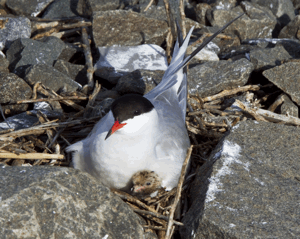
Mother tern and child. (Salt Marsh Diary ©)
Tern ignores them all. She talks to no one. Her destination guarded. Her council recorded only to herself until she hears among all others the one voice that is her Polar Star. Upon a waste of pebbles and shells one waits lonely. It is her daughter, fledged but dependent on her. The features of the childbird softer. Plumage indistinct as if to hide her. In plain sight only her mother finds her and feeds her with a kiss, bill to beak. Then leaves, to seek what other valuables lie out on the shoals of the deeps.

(Salt Marsh Diary ©)
And Daughter cries as if she will never see Mother again. As if she knows. Then Child Tern’s worst fear comes true: The day is coming when fledgling by herself learns to fend, alone, or perish…
[TERNS CALLING]
YOUNG: Mark Seth Lender’s forthcoming book is, “Salt Marsh Diary, A Year on the Connecticut Coast.” He also takes photographs of the wildlife he observes. You can see some great shots at our website, L-O-E dot org.
Related link:
Salt Marsh Diary
[MUSIC: Pierre Dorge “Lili Goes To Town” from Johnny Lives (Steeplechase Records 1987)]
YOUNG: While you’re online, stop by our sister show, Planet Harmony. pH has a profile of former White House Green Jobs Advisor Van Jones. A year after controversy drove him from the Obama administration, Jones is still beating the drum for a Green Collar Economy.
JONES: Just as committed as ever to making sure we have a green wave in our economy and that that green wave lifts all boats. It's really important that folks in Appalachia, and Native American reservations and the rural heartland, get new jobs, get new opportunities. And that is to me the most important thing about the green economy. I was working on that before I went to the White House, got a chance to work on that for six months in the White House and continue to work toward that vision.
YOUNG: Van Jones on Planet Harmony, which welcomes all and pays special attention to stories affecting communities of color - that's My Planet Harmony dot com.
[MUSIC:Bill Laswell “Beyond The Zero” from Dub Chamber 3 (ROIR Records 2000)]
YOUNG: You can hear our program anytime on our website, or get a download for your MP3 player. The address is loe dot org. And, we’d like to hear from you. You can reach us at comments at loe dot org. Once again, comments at loe dot org. Or, share your thoughts on our Facebook page, it’s PRI’s Living on Earth. And, you can call our listener line at 800-218-9988. That’s 800-218-9988.
YOUNG: Just ahead, hitting a new low- the world’s deepest cave. Keep listening to Living on Earth!
[MUSIC: Herbie Mann: “Memphis Underground” from Memphis Underground (Atlantic Records 1969)]
Deepest Places
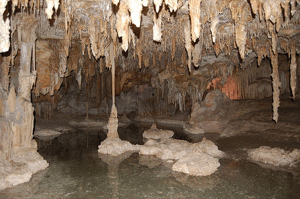
Caving and cave diving are among the most dangerous sports. (Photo: James Tabor)
YOUNG: It’s Living on Earth. I’m Jeff Young. And now, the search for the deepest place on Earth. Finding it involves heading down, down into a super cave more than a mile deep, through miles of maze-like passages, some flooded. There are only about a half dozen of these super caves in the world, and they have proven so difficult to penetrate that explorers only recently discovered which one was actually the deepest. James Tabor has written the book about the rival teams searching for the ultimate cave – it’s called “Blind Descent: The Quest to Discover the Deepest Place on Earth,” he came into the studio for a deep discussion with Living on Earth’s Steve Curwood.
CURWOOD: Why write a book on caving?
TABOR: Because it was the greatest epic of science and adventure and exploration that no one ever heard about. We know immense amounts about Edmond Hillary, Armstrong, Aldrin, Shackelton, Perry, Scott, those people. This happened in 2004, and it went completely under the world’s radar screen. And I thought they deserved recognition, first of all, and also because the eighth continent, the underground world, is so fascinating. I’ve sampled enough of it to know that I thought readers would really be enthralled by this magical, underground world.
CURWOOD: Now, you describe caving in super-caves as climbing Mt. Everest in reverse!
TABOR: Yes.
CURWOOD: What do you mean by that?
TABOR: Well, the expeditions that descend into these super-caves involve scores of participants. They’re on site, not just for weeks, as in Everest, but for months. They cost hundreds of thousands of dollars, they require even more skill sets than Himalayan climbing does because you have to be very good at vertical work, rope work, rock climbing, but you also have to be a world class diver.
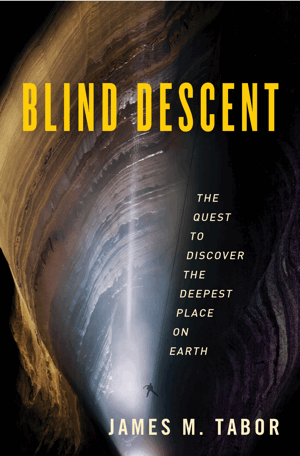
James Tabor’s new book about supercaving.
CURWOOD: Tell me about these deepest places on the planet, that the people you write about in your book were looking for. Where are they, and what remains to be discovered?
TABOR: Well, I’ll focus on Kruber, which did turn out to be the Mt. Everest of caves, the deepest one of all. It’s 7,200ft deep. So you could stack seven empire state buildings in the depth that it represents. Kruber is located in the Republic of Georgia, it’s about two miles of travel through various passages and sumps to get to that bottom.
CURWOOD: Explain a sump to people.
TABOR: A sump is a flooded tunnel. It’s a remarkably cold cave, the water temperature in Kruber is 32 degrees Fahrenheit always, because it’s fed by glacial melt. Air temperature in the summer is about 38 degrees Fahrenheit, but they prefer to climb in winter because there’s less chance of flooding, so then the air temperature is zero, which makes terminal hypothermia in Kruber a really serious possibility. I think the defining characteristics of many great super-caves are the vertical spaces. There’s a pit in Kruber called the grand cascade- 500 vertical feet…[MAKES FALLING NOISE]…just like that. And 90 percent of the terrain in Kruber, which looks in profile like a big elevator shaft, is actually vertical. You’re on rope 90 percent of the time, working your way down into Kruber.
CURWOOD: You know, in culture, the deepest cave is called Hell…
TABOR: (Laughs) That’s correct. And, I think a lot of people would call the kind of conditions that these folks have to encounter, very hellish. There is no rescue if you’re deep, deep, deep down in a super-cave. There’s no communication with the surface for one thing, and if you get hurt, it’s virtually impossible to bring an incapacitated person out through flooded sumps and up 500ft vertical drops.
CURWOOD: The only thing missing in these caves is a guy standing there with a pitchfork, and maybe a little heat, huh?
TABOR: You know, there may be somebody like that waiting down there for us yet, we just don’t know… (laughs)
CURWOOD: So, you’re saying that this is on a par with getting to the moon, getting to the top of Everest, finding the north pole, finding the south pole, all those things… this is a great exploration.
TABOR: I am saying that. This was the last great terrestrial discovery. We’ve been to the top of the mountains, the bottoms of the deepest oceans, the poles, everything. The bottom of the deepest cave on Earth was the last one. And, so, given the risks, and the significance, and the good science that’s gonna come out of it, yes, I would definitely put it on a par with those other things.
CURWOOD: So what was the most important discovery of Kruber? What did they find at the bottom of the deepest place on Earth?
TABOR: I think the most important thing was that they proved that humans can get to that place and that humans can function down there. I will cite just one example of scientific benefit that has come from other deep caves that have opened up. They brought out life-forms called extremophiles-- microbial life-forms. And, in the laboratories, they’re breeding new families of antibiotics from them, which are proving effective against our worst, most drug resistant bacteria.

Caving and cave diving are among the most dangerous sports. (Photo: James Tabor)
CURWOOD: So, what’s your favorite story from your book?
TABOR: It has to do with a relatively young caver named Emil Vash, who was one of the team that finally bottomed Kruber. At one point, deep in the cave, he came to something called the Death Sump, which required a breath-hold dive through a sump about ten feet long. So, it wasn’t very long but it was only 30 inches high, and it was only 18 inches wide, which is the width of your computer keyboard.
CURWOOD: Or a coffin, maybe…
TABOR: Or a coffin! Exactly. And, in fact, he got hung up and he almost did die. But, he extricated himself, came back out, went through a second time and made it. And, I think that grit, that persistence, that refusal to quit, just epitomized everything about super-caving for me.
CURWOOD: If you could read the passage that you have here….
TABOR: Vash had a premonition that he would not make it through, but he pushed on, regardless. He hyperventilated, briefly to blow carbon dioxide out of his system, held a last breath and dove.
His premonition quickly came true. He didn’t submerge deeply enough and halfway through, his helmet caught on a ceiling obstruction. Panicking, he flailed back out of the sump and surfaced, unnerved and gasping. It had been one of the worst moments, perhaps the worst moment, of his life.
Cavers are nothing if not persistent. Calming himself, Vash went in, once again, taking care to go all the way down to the tunnel’s floor, this time. He cleared the ceiling but found, terrifyingly, that the sump was so narrow that it pressed against the surface of his body and helmet. This was a very tight scrabble, while completely submerged, in zero visibility, 32-degree water.
When he finally popped out the other side, there was a weird similarity to birth about the whole thing. The painful passage through a constricted canal, followed by shocking emergence from water to air, in a cold room, where waited an oddly dressed man with lights on his head.
CURWOOD: You know, I’m going to sound biased to say this, but I think you gotta be nuts to do this. Can you imagine diving, I mean, going under water in a dark place, where you also have to be able to climb… I mean, just the thought of that and the claustrophobia starts to rattle in my body!
TABOR: Yeah, it’s not everyone’s cup of tea, by any means! You know, the darkness is absolute, there’s not a single lumen of light, the squeezes that you have to go through, the immense vertical drops, the freezing flooded tunnels and the increasing sense of isolation and aloneness. Really some deep part of the brain says, ‘oh boy, yeah this is kind of hellish.’ And, I think that, with people at that level there is this incredibly deep motivational urge to be first, to go where no one has gone before, and I think it may almost be irresistible.
CURWOOD: It’s the human thing…
TABOR: Exactly.
CURWOOD: To be first?
TABOR: Yes.
CURWOOD: James Tabor’s new book called “Blind Descent: The Quest to Discover the Deepest Place on Earth.” Thanks for taking this time with me, Jim!
TABOR: Thank you so much, I’ve been really glad to be here.
Related link:
James Tabor’s website
[MUSIC: Steely Dan “Caves Of Altimira” from Royal Scam (UMG Recordings 1976)]
YOUNG: Just ahead – putting a destructive tool to creative use. But first, this note on Emerging Science from Amanda Martinez.
Science Note: Belching Sheep
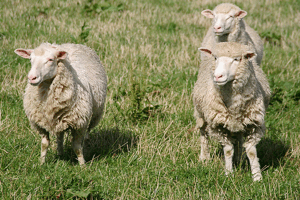
The belching culprits. (Photo: Marilyn Jane)
MARTINEZ: Coriander, turmeric and a dash of cumin may sound like the ingredients of any good curry, but to a group of British scientists, the spices may be a recipe to fight climate change.
[THEME]
Step into a pasture full of grazing livestock and you’ll hear a lot more than moos and baas. You’ll also get an earful of belching. Such burps might be funny if it weren’t for the damage they do to the atmosphere. They release great quantities of methane, a greenhouse gas 30 times more potent than carbon dioxide.
But researchers at Newcastle University in the U.K. recently found that certain spices could significantly reduce these methane emissions. The scientists added crushed coriander, cinnamon, turmeric, cloves and cumin to a solution designed to mimic the mixture of fluids and microorganisms within a sheep’s gut. The spices function somewhat like an antibiotic, killing methane-generating bacteria, while still allowing beneficial bacteria to thrive. Coriander and turmeric were most effective, cutting methane release by 40 and 30 percent, respectively.

The belching culprits. (Photo: Marilyn Jane)
Providing digestive relief to the world’s nearly billion sheep would be a coup, as each animal emits 20 liters of methane daily. But the scientists’ next step is to see if the spices will also work for cattle. Each of the world’s 1.3 billion cows belches a whopping 500 liters of the heat-trapping gas every day. Given the similarities between the animals’ stomachs, the researchers are optimistic. The spices could prove a natural and inexpensive way to reduce the 18 percent of greenhouse gases livestock contribute to the atmosphere each year. Whether cows or sheep will favor the flavor of curry seasonings, however, remains to be seen.
And that’s this week’s note on Emerging Science. I’m Amanda Martinez.
A Man and His Chainsaw
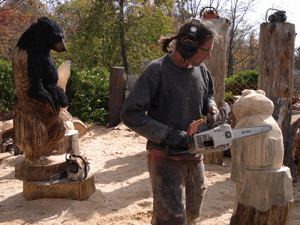
Ken Packie sculpting. (Photo: Laurie Sanders)
YOUNG: Chainsaws are pretty rugged instruments. Good for cutting firewood and clearing fallen trees, very useful as horror movie props. But not something you typically think of as an implement of art. And yet, Producer Laurie Sanders brings us the story of a man who carves out a living as a chainsaw artist.
[WHIRRING CHAIN SAW]
SANDERS: In the last ten years, chainsaw carving has come a long way.
PACKIE: I mean, it’s really being looked at as art and not as carnival carving.
SANDERS: Ken Packie is a full-time chainsaw carver in Otis, MA. He says because of national and international competitions, chainsaw carving has gotten much more sophisticated.
PACKIE: The realism and the form, it’s just gotten so good. In Germany and Japan you have a lot of classically trained artists who have gone to the chainsaw.
SANDERS: Packie is among an elite, new breed of chainsaw sculptors. Watching him is mesmerizing. He wields a chainsaw with speed and grace and accuracy. As he slices and shaves, the log in front of him is transformed into something else. Today he’s working on a life-size bald eagle.
[CHAINSAW]
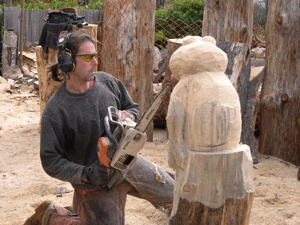
Ken Packie at work. (Photo: Laurie Sanders)
PACKIE: Eagles or any bird really, is challenging to get their feather layout right and get that sense of motion that they have. And I find the key, really, is a bit of randomness in the feather pattern. Some longer and shorter, some ruffled, splits in some because nothing is really ever perfect in nature.
SANDERS: And the logs Packie uses aren’t perfect either. They’re what most people would consider junk wood. Here at his shop on Route 23, Packie is surrounded by several piles.
PACKIE: The wood comes from home owners, local tree service guys, and from professional timber clearing companies. And this is the small pile. I have a landing out in Monterey with a lot of pieces about the size of that one and bigger, that this company had taken down, and they are just too big for the mills. So the tree guys will bring it right here.
SANDERS: Most often Packie uses white pine. It doesn’t dry and split as much as the hardwoods, and he can easily get big trunks, which he likes to work with.
Now, before going any further, you should know that Packie never touched a chainsaw until a few years ago. He’s spent most of his career working as a telecom technician in New York City and Washington DC. He moved to western Massachusetts a few years ago to start work with a new telecom firm, and around that time he and his wife went to a home show where he saw someone chainsaw carving.
PACKIE: And it just got filed away as something to try. And another year went by and in October of 2005, I decided to go ahead and try it. But being from Jersey and never using a chainsaw, I thought it was best to get lessons. So I found somebody out in Washington state giving a three-day class, and I got hooked immediately. I realized I could see in 3-D. I could see where I was supposed to be going, I could see what should be coming off. I wish I would have discovered this 20 years ago. You know, as soon as I took that class, I knew right then, this is what I should be doing.

Ken Packie sculpting. (Photo: Laurie Sanders)
SANDERS: He started small. Whenever he had a free moment from work, he would carve. He took vacation days to carve. He met other carvers. Now he can carve almost anything, but his preference is realistic carvings of local wildlife. To get the proportions right, Packie says he looks at lots of photographs. Side shots, head shots, the length of the forearms. The relationship between the eyes, nose and skull. But when he carves, there’s never a measuring tape. It’s all done by eye.
PACKIE: I guess I’m trying to honor, in a way, in the individual animals by replicating them as real as possible and capturing part of what an eagle does here feeding, swooping down feeding. I’m trying to capture a snapshot of an animal for people who may not spend time out on a lake, looking for it to happen, for them to enjoy.
SANDERS: And where do these ideas come from? Just from his head.
PACKIE: Some carvers say there’s something definite in there and they’re just bringing it out. And it doesn’t work for me like that. I mean, I have the ideas in my head. A split piece like this one, I look at that and I can see maybe two otters, spiraling down, chasing a fish down here at the bottom. There could be a couple of owls, or a hawk sitting down here with two crows giving him a hard time.
SANDERS: After getting the piece close to where he wants it, he says the next step is to burn it with a torch.
[SOUND OF TORCH]
PACKIE: I refer to what I do as using chainsaws, chisels and fire to create what I create. And fire is the fun part. It’s doing two things: it’s cleaning up all of this furring that you see that you develop with the chainsaw. It cleans that up a little bit, and it’s providing a little bit of shading.
SANDERS: He uses sanders and other equipment for the fine details.
PACKIE: When I get to the eyes and some of the face details, I like to use hand chisels. I like to turn everything off, and it’s quiet, and then you can really get exactly the tilt of the eye, and get the lid the way you want it, and you can really get the expression you’re looking for by using chisels.
[SOUND OF CHISELS]
SANDERS: Packie’s work is considered so good that in 2009, he was recognized by United Chainsaw Carver’s Guild as its “emerging artist of the year.” This year, he’s been selected to participate in several invitation-only chainsaw sculpting competitions. And not only here in the US, but also in Canada, England, Scotland, Germany and Japan. For Living on Earth, I’m Laurie Sanders.
Related links:
- Wood Sculptures by Ken Packie
- United Chainsaw Carvers Guild
YOUNG: We have pictures of Packie’s work at our website, L-O-E dot org.
[MUSIC: Ernest Ranglin: “Straight Flush” from Orders Of Distinction (Jobby LLC 2007)]
YOUNG: On the next Living on Earth, sea level predictions prompt California to rethink new shore-side development.
VOICE: We may decide that the best thing to do is have buildings that are specifically designed to only last 50 or 100 years, and then they can be disassembled, they can be moved away.
YOUNG: Also, we continue our coverage of Louisiana politics. That’s next time on Living on Earth… And by the way, if you’re wondering about the results from the Louisiana race we reported on last week, there will be a runoff in the third congressional district on the GOP side - there’s a lot more at L-O-E dot org.
[SOUNDS]
YOUNG: We leave you this week in the garden of Enko-ji Temple in Kyoto.
YOUNG: A Suikinkutsu (SUI-kin-koot-sue), which literally means “Water-zither-cave, ” is an ancient Japanese instrument used for washing before the Japanese tea ceremony. Water drips from a stone basin into a buried ceramic bowl. Bamboo tubes magnify the dripping, creating a peaceful sound. On a summer eve, cicadas added their own rhythms. Steve Feld brought all these sounds together for what he calls a “soundscape composition”.
[SOUNDS]
YOUNG: Living on Earth is produced by the World Media Foundation. Our crew includes Bobby Bascomb, Eileen Bolinsky, Bruce Gellerman, Ingrid Lobet, Helen Palmer, Jessica Ilyse Smith, Ike Sriskandarajah, and Mitra Taj, with help from Sarah Calkins, and Sammy Sousa. This week we bid farewell to our wonderful interns, Amanda Martinez, Meghan Miner and Amie Ninh. You’ve been fantastic, and we wish you the best of luck. Jeff Turton is our technical director. Alison Lirish Dean composed our themes. Steve Curwood is our Executive Producer. You can find us anytime at L-O-E dot org- and check out our Facebook page- PRI’s Living on Earth. I’m Jeff Young- thanks for listening.
ANNOUNCER: Funding for Living On Earth comes from the National Science Foundation supporting coverage of emerging science. And Stonyfield farm, organic yogurt and smoothies. Stonyfield pays its farmers not to use artificial growth hormones on their cows. Details at Stonyfield dot com. Support also comes from you, our listeners. The Ford Foundation, The Town Creek Foundation, The Oak Foundation—supporting coverage of climate change and marine issues. And Pax World Mutual Funds, integrating environmental, social, and governance factors into investment analysis and decision making. On the web at Pax world dot com. Pax World for tomorrow.
ANNOUNCER 2: PRI – Public Radio International
Living on Earth wants to hear from you!
Living on Earth
62 Calef Highway, Suite 212
Lee, NH 03861
Telephone: 617-287-4121
E-mail: comments@loe.org
Newsletter [Click here]
Donate to Living on Earth!
Living on Earth is an independent media program and relies entirely on contributions from listeners and institutions supporting public service. Please donate now to preserve an independent environmental voice.
NewsletterLiving on Earth offers a weekly delivery of the show's rundown to your mailbox. Sign up for our newsletter today!
 Sailors For The Sea: Be the change you want to sea.
Sailors For The Sea: Be the change you want to sea.
 The Grantham Foundation for the Protection of the Environment: Committed to protecting and improving the health of the global environment.
The Grantham Foundation for the Protection of the Environment: Committed to protecting and improving the health of the global environment.
 Contribute to Living on Earth and receive, as our gift to you, an archival print of one of Mark Seth Lender's extraordinary wildlife photographs. Follow the link to see Mark's current collection of photographs.
Contribute to Living on Earth and receive, as our gift to you, an archival print of one of Mark Seth Lender's extraordinary wildlife photographs. Follow the link to see Mark's current collection of photographs.
 Buy a signed copy of Mark Seth Lender's book Smeagull the Seagull & support Living on Earth
Buy a signed copy of Mark Seth Lender's book Smeagull the Seagull & support Living on Earth

